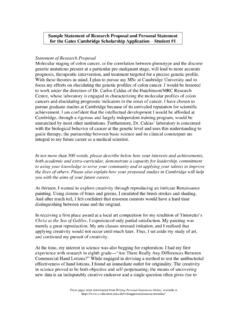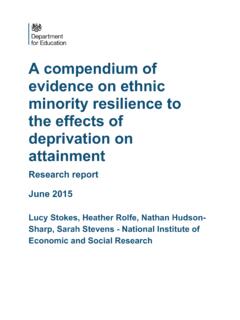Transcription of Media representations of black young men and boys
1 Media representations of black young men and boys Report of the REACH Media monitoring project Stephen Cushion, Kerry Moore and John Jewell School of Journalism, Media and Cultural Studies Cardiff University This report was commissioned by the previous government and is not necessarily a reflection of the current government s policies and priorities. DCLG is publishing the report in the interests of transparency. Crown copyright 2011 You may re-use this information (not including logos) free of charge in any format or medium, under the terms of the Open Government Licence. To view this licence, visit or write to the Information Policy Team, The National Archives, Kew, London TW9 4DU, or e-mail: This document/publication is also available on our website at If you require this publication in an alternative format please email: Any enquiries regarding this document/publication should be sent to us at: Department for Communities and Local Government Eland House Bressenden Place London SW1E 5DU Telephone: 030 3444 0000 2011 ISBN: 978-1-4098-2818-1 Contents Executive summary.
2 2 Introduction .. 5 Literature review .. 8 Methodology .. 17 Chapter One: A content analysis of young men and boys in the news .. 23 Chapter Two: A content analysis of black young men and boys in the 36 Chapter Three: black young men and boys in gun and knife crime news .. 57 Chapter Four: black young men and boys in Current Affairs Documentaries .. 70 Chapter Five: black young men and boys in black and minority ethnic Media .. 74 Chapter Six: Interviews with Journalists and Editors .. 81 Conclusion .. 87 References .. 91 Appendix A: Coding frame for quantitative 94 Appendix B: Detailed tables of data relating to coverage of all men and boys .. 97 Appendix C: Detailed tables of data relating to coverage of black young men and boys .. 99 Appendix D: Analysis of the REACH Campaign and role modelling programme Coverage .. 102 1 Executive summary This report provides an extensive analysis of Media coverage of black young men and boys in the British news and current affairs Media .
3 The central aim of the research is to understand how the news Media represent black young men and boys , and specifically, to consider whether there is evidence of negative stereotyping of black young men and boys in the news Media . The report begins by discussing the results of a quantitative analysis of Media news stories about young men and boys generally, followed by more detailed analysis of Media news stories involving black young men and boys . This is followed by an in-depth qualitative analysis of Media stories about black young men and boys related to crime; an analysis of black and minority ethnic Media coverage; and finally the results of a series of qualitative interviews with those involved in making and reporting the news. Overall, the dominant discourse surrounding black young men and boys in the news Media links them with violent crime, and particularly murders involving knives and/or gangs.
4 While this is clearly a negative Media image, no clear or explicit stereotype of black young men or boys was constructed across news reports. In the mainstream news, young men and boys were regularly reported in relation to negative news values, just over 4 in 10 stories being crime-related,1 while stories about wider social issues, such as education and health, were not as frequently or prominently reported. However, close to 7 in 10 stories of black young men and boys related in some form to crime - a comparatively higher figure than in coverage of young men and boys more generally. Violent crime, murders, and gun and knife crime accounted for the majority of crime coverage featuring black young men and boys in the mainstream news, with little context or explanation for the reasons why crime was committed. In gun or knife crime news, the race or ethnic background of the young men or boys , as either victims or perpetrators, was rarely explicitly mentioned, but in a small minority of tabloid articles the black identity of young male perpetrators was reported as if relevant to their criminal activities.
5 The magnitude of knife crime as a contemporary social problem involving black young men or boys was emphasised in many articles drawing an equivalence between a variety of stories involving knife crime fatalities, which were often very different in circumstance or context. 1 Includes monitoring periods 1 to 4 and the 10 per cent sample obtained in monitoring periods 5 to 8 2 When young people featured as victims of crime in the news, sympathy appeared conditional upon an image of social respectability and legitimacy, especially a lack of connection to gangs or gang culture. In a very few tabloid newspaper articles, young black males (and their families) were constructed as if symbolically representing problems associated with knife crime. There was also some evidence of an assumption in certain sections of the tabloid press that a young male victim of knife crime may be involved in gangs.
6 In current affairs documentaries black young men and boys also featured largely in association with crime issues especially street violence, gun and knife crime and gangs and as both victims and as perpetrators of crime. Systemic issues shaping the experiences of black young men or boys as vulnerable young people were explored, but the behaviours and attitudes of some of those represented also associated black young men and boys with a potentially violent or criminal threat to the wider society. The black and minority ethnic news Media did not shy away from commenting or reporting on crimes committed by black young men and boys , but they did attempt to provide a context and address some of the issues that may lead to crime. By contrast with the mainstream news, the discussion of education and issues of racism were prominent within the coverage of the black and minority ethnic news Media .
7 The black and minority ethnic news Media afforded black sources and commentators a forum to present opinions that did not seem, ordinarily, to be available in the mainstream press. black and minority ethnic news Media also provided black young men and boys themselves with a voice and a platform to challenge perceived stereotypes. Journalists and editors acknowledged that coverage of black young men and boys tends to be predominantly negative. While open to covering other, potentially more positive stories about black young men and boys , journalists felt that proactive investigation would be necessary to find such stories something constrained by the desk-based nature of contemporary journalistic practice, in which journalists tend to rely on electronically delivered information and established sources of news. There was a clear awareness amongst journalists and editors of press regulations regarding the identification of ethnicity in news reports.
8 Respondents firmly asserted that, in reporting crime, they did not consider the black identity of perpetrators to be relevant to the news value of a story. Yet, at the same time, it was noted that an image associating black young men and boys with gun and knife crime did exist, and that such stories did appear to be high on the news agenda. 3 Interview respondents also highlighted that there are still comparatively few people working in mainstream journalism from a black or minority ethnic background. Because of this it was felt, the daily lives of black young men and boys are far removed from the experience of the majority of those working in journalism, particularly from the decision makers in higher-level jobs. Without knowing to what extent black young men and boys themselves either access or interpret these news sources, it is not possible to assess what impact the coverage has on their own self-perceptions and, linked to that, their aspirations.
9 It is however reasonable to assume that the negative portrayal of black boys and young black men in news Media may well impact on the wider readership and viewing public's perceptions of these groups. That perception, in turn, may impact on black boys and black young men to a significant extent. 4 Introduction The REACH Media Analysis Report provides an extensive analysis of the coverage of black young men and boys 2 in the British news and current affairs Media . The central aim of the research project has been to explore how the news Media in Britain represents young males and to identify and seek to understand the dominant discourses with which black young men and boys are associated in the UK news. In this, we respond to a set of policy research aims of the Department for Communities and Local Government (CLG) developed from the REACH programme a policy which aims to raise the levels of achievement and the aspirations of black young men and boys in England.
10 The REACH report, published in 2007, identified negative Media stereotypes and a lack of positive role models as factors contributing to under- achievement amongst black young men and boys in education and the labour market. The report suggested that a negative public and self image, fuelled by the Media , is likely to impact upon the aspirations and achievement levels of black young men and boys . The REACH Media Analysis study aims to critically scrutinise the negative Media image supposed by the REACH Report and to demonstrate whether, how, and the extent to which, negative images or stereotypes do surround black young men and boys in the news Media . It is intended that our research will then inform policy discussions considering how news Media representations of black young men and boys might influence their social experiences, aspirations and opportunities. As Media scholars, these aims immediately raise difficult and complex questions about the power of the news Media , its relation to social relations in general, and of issues of race , gender and the social experiences of young people in particular.






